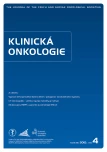HARDROCK Project: Parametric Data Collection and Analysis of Patients with Head and Neck Cancer in the Comprehensive Cancer Centre of Ostrava – Role of Fractionation and Target Volume Definition in Radiotherapy
Authors:
M. Halámka 1; D. Feltl 1; J. Cvek 1; L. Dušek 2
Authors‘ workplace:
Klinika onkologická, FN Ostrava
1; Institut biostatistiky a analýz, Masarykova univerzita Brno
2
Published in:
Klin Onkol 2012; 25(4): 274-281
Category:
Original Articles
Overview
Background:
The HARDROCK project has been designed as a retrospective data collection study in a locally run database system, which fulfils the requirements on the basic version of electronic medical records of cancer patients. The diagnostic category of head and neck tumors has been selected on purpose, as it presents a major problem in the Comprehensive Cancer Centre of Ostrava, and it is relevant given the high incidence and mortality in the Moravian-Silesian Region. The target parameters of the assessment include short-term as well as long-term treatment results in patients with head and neck tumors, evaluated with standard indicators of treatment response and survival. A special emphasis is put on major treatment modalities, i.e. surgery and radiation therapy, and on related complications.
Patients and Methods:
In this article, we present a sample of collected data. The data from patients has been separated into two groups based on the time of their acquisition: data from patients treated in 2004–2005 versus patients treated in 2006–2010. This division was given by the change of treatment protocols in 2006 introducing accelerated radiotherapy with concomitant boost and expanded lymph node irradiation field compared to normofractionation and hyperfractionation regimes used before 2006.
Results:
Introduction of new irradiation techniques did not increase the rate of acute toxicity but slightly increased late toxicity. Further, we found a decrease of number of relapse and improved overall survival in patients with stage IV disease treated in 2006–2010.
Conclusion:
The project results will contribute methodically to the exact evaluation of diagnostics and treatment of patients with head and neck cancer and will help to optimize their medical care.
Key words:
head and neck cancer – radiotherapy – population register
The authors declare they have no potential conflicts of interest concerning drugs, products, or services used in the study.
The Editorial Board declares that the manuscript met the ICMJE “uniform requirements” for biomedical papers.
Submitted:
18. 1. 2012
Accepted:
10. 4. 2012
Sources
1. Lingen MW. Head and neck. In: Kumar V, Abbas AK, Fausto N et al (eds). Robbins and Cotran Pathologic Basis of Disease. 8th ed. Philadelphia: Saunders Elsevier 2010 : 740–753.
2. Šlampa P, Petera J. Zhoubné nádory hlavy a krku. In: Vošmik M, Šlampa P, Kubeš J et al (eds). Radiační onkologie. Praha: Galén Karolinum 2007 : 67–104.
3. Kreimer AR, Clifford MG, Boyle P et al. Human papillomavirus types in head and neck squamous cell carcinomas worldwide: a systematic review. Cancer Epidemiol Biomarkers Prev 2005; 14(2): 467–475.
4. Termine N, Panzarella V, Falaschini S et al. HPV in oral squamous cell carcinoma vs head and neck squamous cell carcinoma biopsies: a meta-analysis (1988–2007). Ann Oncol 2008; 19(10): 1681–1690.
5. Chaturvedi AK, Engels EA, Anderson WF et al. Incidence trends for human papillomavirus-related and -unrelated oral squamous cell carcinomas in the United States. J Clin Oncol 2008; 26(4): 612–619.
6. Ústav zdravotnických informací a statistiky ČR. Novotvary 2005–2007 [online]. Praha: ÚZIS 2005–2007. Dostupné na: http://www.uzis.cz.
7. Licitra L, Felip E. ESMO Guidelines Working Group. Squamous cell carcinoma of the head and neck: ESMO clinical recommendations for diagnosis, treatment and follow-up. Ann Oncol 2009; 20 (Suppl 4): 121–122.
8. Bonner JA, Harari PM, Giralt J et al. Radiotherapy plus cetuximab for squamous-cell carcinoma of the head and neck. N Engl J Med 2006; 354(6): 567–578.
9. Harrington KJ, El-Hariry IA, Holford CS et al. Phase I study of lapatinib in combination with chemoradiation in patients with locally advanced squamous cell carcinoma of the head and neck. J Clin Oncol 2009; 27(7): 1100–1107.
10. Parsons JT, Mendenhall WM, Cassisi NJ et al. Hyperfractionation for head and neck cancer. Int J Radiat Oncol Biol Phys 1988; 14(4): 649–658.
11. Bourhis J, Overgaard J, Audry H et al. Hyperfractionated or acclerated radiotherapy in head and neck cancer: a meta-analysis. Lancet 2006; 368(9538): 843–854.
12. Terhaard CH, Kal HB, Hordijk GJ. Why to start the concomitant boost in accelerated radiotherapy for advanced laryngeal cancer in week 3. Int J Radiat Oncol Biol Phys 2005; 62(1): 62–69.
13. Feltl D, Cvek J. Klinická radiobiologie. 1st ed. Havlíčkův Brod: Tobiáš 2008 : 57–66.
14. HARDROCK, Head and neck cancer: Assessment of risk factors, stage distribution, radiotherapy optimalization, couses of relapse – keypoints [online]. Available from: http://hardrock.registry.cz.
15. Radiation Therapy Oncology Group, Cooperative Group Common Toxicity Criteria [online]. Available from: http://www.rtog.org/ResearchAssociates/AdverseEventReporting/AcuteRadiationMorbidityScoringCriteria.aspx.
Labels
Paediatric clinical oncology Surgery Clinical oncologyArticle was published in
Clinical Oncology

2012 Issue 4
- Metamizole at a Glance and in Practice – Effective Non-Opioid Analgesic for All Ages
- Metamizole in perioperative treatment in children under 14 years – results of a questionnaire survey from practice
- Obstacle Called Vasospasm: Which Solution Is Most Effective in Microsurgery and How to Pharmacologically Assist It?
- Possibilities of Using Metamizole in the Treatment of Acute Primary Headaches
- Metamizole vs. Tramadol in Postoperative Analgesia
Most read in this issue
- Hepatocellular Carcinoma – Long-Term Treatable Disease
- Treatment For Volume Upgrading of the Low-Grade Supratentorial Glioma After the Subtotal Neurosurgical Resection
- EGFR Mutations in Patients with Advanced NSCLC
- CT Colonography – Evolution of Methodology and Indications
